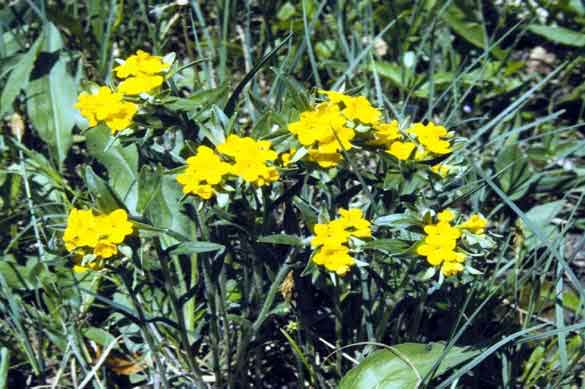
Lithospermum canescens, U.S. Environmental Protection Agency, Great Lakes National Program Office
Classification System: APG IV
Superregnum: Eukaryota
Regnum: Plantae
Cladus: Angiosperms
Cladus: Eudicots
Cladus: Core eudicots
Cladus: Asterids
Cladus: Lamiids
Ordo: Boraginales
Familia: Boraginaceae
Subfamilia: Boraginoideae
Tribus: Lithospermeae
Genus: Lithospermum
Species: Lithospermum canescens
Name
Lithospermum canescens (Michx.) Lehm., Pl. Asperif. Nucif.: 305 (1818).
Synonyms
Anchusa canescens (Michx.) Muhl.
Batschia canescens Michx.
Batschia conspicua R.Br.
Batschia sericea Roem. & Schult.
Lithospermum conspicuum Spreng.
Lithospermum sericeum Lehm.
Homonyms
Lithospermum canescens Torr. = Lithospermum californicum A.Gray
Distribution
Native distribution areas:
Continental: Northern America
Regional: Southeastern USA
Alabama, Illinois, Kentucky, Tennessee.
References: Brummitt, R.K. 2001. TDWG – World Geographical Scheme for Recording Plant Distributions, 2nd Edition
References
Primary references
Lehmann, J.G.C. 1818. Plantae e Familiae Asperifoliarum Nuciferae. 516 pp. Berlin. Google Reference page. : 2:305.
Links
Govaerts, R. et al. 2020. Lithospermum canescens in Kew Science Plants of the World online. The Board of Trustees of the Royal Botanic Gardens, Kew. Published online. Accessed: 2020 Oct 07. Reference page.
International Plant Names Index. 2020. Lithospermum canescens. Published online. Accessed: Oct 07 2020.
Tropicos.org 2020. Lithospermum canescens. Missouri Botanical Garden. Published online. Accessed: 07 Oct 2020.
Catalogue of Life: 2021 Annual Checklist
USDA, ARS, Germplasm Resources Information Network. Lithospermum canescens in the Germplasm Resources Information Network (GRIN), U.S. Department of Agriculture Agricultural Research Service. Accessed: 07-Oct-06.
Vernacular names
English: Hoary Puccoon, hoary gromwell
Lithospermum canescens, or the hoary puccoon is a perennial herb endemic to eastern North America. The plant grows in a variety of habitats. It has golden yellow flowers which bloom from April to May.[3]
Description
Lithospermum canescens grows to 6–16 in (150–410 mm) in height, growing from a thick, red, woody taproot with one to several stems that are usually not branched. Its leaves are alternate and oblong, and lack a petiole. The leaves range around 1–2 in (25–51 mm) in length and have any width under 0.5 in (13 mm). Both the leaves and stems are grey-green and pubescent, meaning they are covering with many short, silky, erect trichomes, or hairs.[4]
Its flowers are tubular and cluster at the terminal racemes, or at the end of stems. They are commonly yellow to orange in hue and are about 0.5 in (13 mm) in diameter. The fruit of the plant is a hard, smooth, yellowish-white seedlike nutlet.[4]
Taxonomy
The genus name lithospermum comes from the Greek lethos, meaning "stone", and sperma, meaning "seed", referencing the stone-like seeds of the plant. The species name canscens means "white with age", referencing the short, white hairs that cover the plant.[5]
The common name "hoary puccoon" also references the short, white trichomes on the plant, as hoary also means "white or grey with age, and the word "puccoon" comes from a Native American word meaning "a plant that yields a pigment".[5]
Distribution and habitat
The plant commonly grows in dry to moderately moist soils, in prairies, woodlands, and the edges of roads. It seldom grows in sandy soils.[6]
It grows throughout the eastern United States, from eastern Nebraska to Georgia.[4]
Uses
Native American children chew the plant with their gum to dye it red, as referenced in the common name "hoary puccoon". The taproot produces the reddish-purple juice that is commonly used as a pigment.[7] Native Americans also use the roots of the plant to treat asthma or any lung complaints, and as a sedative.[2] The Menomini peoples used the ripened, white seed of the plant as a type of ceremonial bead.[5]
References
"Lithospermum canescens". NatureServe Explorer. NatureServe. Retrieved 2009-04-06.
Umberto Quattrocchi (2012). CRC World Dictionary of Medicinal and Poisonous Plants: Common Names, Scientific Names, Eponyms, Synonyms, and Etymology (5 Volume Set). CRC Press. p. 2302. ISBN 9781420080445.
Carman, Jack B. (2001). Wildflowers of Tennessee. Highland Rim Press. p. 212.
Jon Farrar (2011). Field Guide to Wildflowers of Nebraska and the Great Plains: Second Edition Bur Oak Guide (revised ed.). University of Iowa Press. p. 106. ISBN 9781609380724.
Sylvan T. Runkel, Dean M. Roosa (2009). Wildflowers of the Tallgrass Prairie: The Upper Midwest Bur Oak Guide (revised ed.). University of Iowa Press. p. 17. ISBN 9781587298448.
Edward G Voss, Anton A Reznicek (2012). Field Manual of Michigan Flora (illustrated ed.). University of Michigan Press. p. 475. ISBN 9780472118113.
Melvin Randolph Gilmore (1919). Uses of Plants by the Indians of the Missouri River Region. U.S. Government Printing Office. p. 111.
Retrieved from "http://en.wikipedia.org/"
All text is available under the terms of the GNU Free Documentation License

